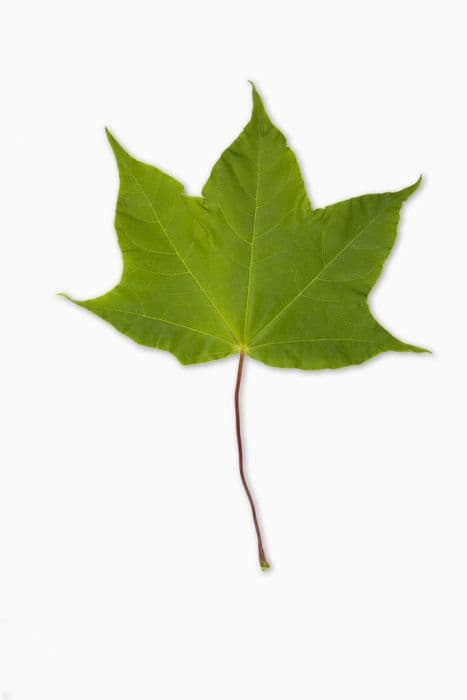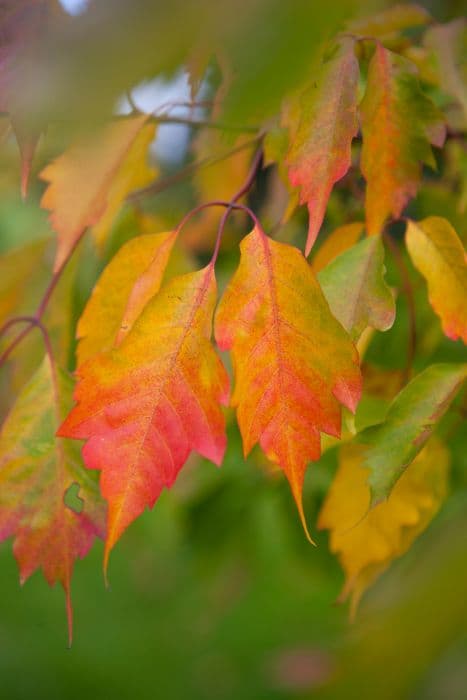Japanese Maple Acer palmatum 'Beni-tsukasa' (P/v)

ABOUT
The 'Beni-tsukasa' variety of Japanese maple is a striking ornamental plant known for its eye-catching foliage. Its leaves are intricately shaped, with multiple pointed lobes reminiscent of a hand with outstretched fingers. The leaves have a delicate texture, which adds a fine, lacy quality to the plant's overall appearance. When new leaves emerge, they display a beautiful range of colors that can include shades of pink, red, and even a touch of cream, creating a variegated look that is highly prized in garden landscapes. As the seasons change, the Japanese maple's leaves undergo a dramatic transformation. The foliage deepens to rich tones that can range from an intense green with an overlay of red to deep purple hues. This chameleon-like quality makes the plant a focal point in any garden throughout the growing season. In fall, the leaves put on their final show, as they shift to vivid shades of red or orange, offering a stunning contrast to the cooling temperatures and shorter days. The branching structure of the 'Beni-tsukasa' Japanese maple is equally elegant, with branches that grow in a graceful, somewhat horizontal manner. This gives the tree a layered appearance, providing depth and texture to the overall form of the plant. The bark is typically smooth and adds a subtle structural interest to the landscape even in the winter months when the branches are bare. Overall, the 'Beni-tsukasa' Japanese maple is a highly decorative plant that is cherished for its seasonal color transitions and delicate, layered growth habit. It is often used in garden designs that seek to emphasize natural beauty and tranquility, making it a popular choice for both traditional and contemporary landscapes.
About this plant
 Names
NamesFamily
Sapindaceae
Synonyms
Red-leaf Japanese Maple, Beni-tsukasa Japanese Maple
Common names
Acer palmatum 'Beni-tsukasa'.
 Toxicity
ToxicityTo humans
Japanese maple is not considered toxic to humans. There are no well-documented cases of poisoning from ingesting parts of this plant.
To pets
Japanese maple is generally not considered toxic to pets. Ingestion of this plant typically does not result in poisoning or serious consequences for pets.
 Characteristics
CharacteristicsLife cycle
Perennials
Foliage type
Deciduous
Color of leaves
Variegated
Height
6-8 feet (1.8-2.4 meters)
Spread
4-6 feet (1.2-1.8 meters)
Plant type
Tree
Hardiness zones
5-8
Native area
Japan
Benefits
 General Benefits
General Benefits- Ornamental Appeal: Adds visual appeal with its unique red, pink, and green tri-colored leaves.
- Seasonal Interest: Offers a changing palette of colors throughout the seasons, from spring to fall.
- Compact Size: Suitable for small gardens or spaces due to its relatively small stature compared to other trees.
- Shade Tolerance: Adapts well to a variety of light conditions including partial shade.
- Cold Hardy: Capable of withstanding cooler temperatures, which is beneficial for gardeners in cooler climates.
- Low Maintenance: Requires minimal pruning and care once established.
- Attracts Wildlife: Can provide habitat and food for birds and beneficial insects.
- Japanese Garden Design: Ideal for themes requiring Japanese maple species for an authentic look.
- Versatile Landscaping: Can be used in various landscaping designs, such as focal points or in containers.
 Medical Properties
Medical PropertiesThis plant is not used for medical purposes.
 Air-purifying Qualities
Air-purifying QualitiesThis plant is not specifically known for air purifying qualities.
 Other Uses
Other Uses- Photography Backdrop: Japanese Maple 'Beni-tsukasa' provides a stunning backdrop for autumn photography sessions with its deep red hues setting a dramatic mood.
- Artistic Inspiration: Artists often use Japanese Maple as a subject for painting or drawing due to its striking coloration and elegant form.
- Bonsai: 'Beni-tsukasa' can be cultivated as a bonsai tree, requiring careful pruning and shaping to maintain its miniature size.
- Theme Gardens: It can be incorporated into themed gardens, such as Japanese Zen gardens, to enhance the aesthetic and symbolic elements of the space.
- Cultural Events: Japanese Maple branches may be used in cultural festivals or ceremonies, particularly those celebrating the changing seasons.
- Leaf Casting: Its leaves can be used in craft projects like leaf casting, where real leaves are used to create concrete or plaster sculptures.
- Education: Botanical gardens and arboretums use it to educate visitors about different types of maples as well as Japanese horticultural practices.
- Printmaking: The leaves of 'Beni-tsukasa' can be used in printmaking to create unique patterns and textures in artworks.
- Seasonal Decorations: They can be incorporated into fall decorations, using branches and leaves in floral arrangements or wreaths.
- Photography Projects: The distinctive look of the Japanese Maple serves as an ideal subject for macro photography, showcasing the intricacy of its leaves and branches.
Interesting Facts
 Feng Shui
Feng ShuiThe Japanese Maple is not used in Feng Shui practice.
 Zodiac Sign Compitability
Zodiac Sign CompitabilityThe Japanese Maple is not used in astrology practice.
 Plant Symbolism
Plant Symbolism- Beauty: The Acer palmatum 'Beni-tsukasa', commonly known as the Japanese Maple, is highly regarded for its aesthetic appeal and diverse coloring, symbolizing beauty in nature.
- Peace: The serene growth habit and graceful shape of the Japanese Maple evoke a sense of calm and peace.
- Change: As a tree that displays vivid foliage transitions, the Japanese Maple is associated with change and the passage of time, highlighting nature's fleeting and transformative beauty.
- Elegance: The elegant structure and leaves of the Japanese Maple are considered emblematic of elegance and sophistication in the world of plants.
- Balance: With its balanced and harmonious growth, the Japanese Maple is frequently seen as representing balance and harmony in life.
 Water
WaterThe Japanese Maple, specifically the 'Beni-tsukasa' variety, should be watered regularly to keep the soil consistently moist but not waterlogged. In the growing season, water this tree once or twice a week, providing approximately 1.5 gallons of water each time for young trees and up to 4 gallons for mature trees, depending on the rainfall and temperature. During hot or dry periods, increase the frequency as needed, but always allow the soil to dry slightly between waterings. Less water may be required during the winter months when the tree is dormant. It's crucial to provide deep watering to encourage a strong root system rather than frequent light sprinklings.
 Light
LightThe 'Beni-tsukasa' Japanese Maple thrives best in partial shade, though it can tolerate full sun in cooler climates. In regions with harsher sunlight, it benefits from protection during the hottest parts of the day to prevent leaf scorch. A spot that receives morning sunlight with afternoon shade or dappled light throughout the day is ideal for maintaining the vibrant foliage color.
 Temperature
TemperatureJapanese Maple prefers a temperate climate with temperatures ranging from 20°F to 90°F, but it's capable of withstanding brief periods outside of this range. The ideal temperature for 'Beni-tsukasa' is between 60°F and 80°F. It can survive winter temperatures down to about -10°F, although significant cold may damage young shoots.
 Pruning
PruningPrune the 'Beni-tsukasa' Japanese Maple in late winter to early spring to remove any dead or intersecting branches and to maintain its shape. This also encourages healthier growth during the growing season. Pruning may be performed annually or every two to three years, depending on the tree's performance and desired aesthetic. The best time for major shaping is when the tree is still dormant.
 Cleaning
CleaningAs needed
 Soil
SoilJapanese Maple 'Beni-tsukasa' prefers a well-draining, acidic to slightly acidic soil mix with a pH of 5.5 to 6.5. A mix of 1 part peat, 1 part pine bark, and 1 part coarse sand or perlite is recommended to provide the right texture and fertility.
 Repotting
RepottingJapanese Maple 'Beni-tsukasa' should be repotted every 2-3 years, preferably in the early spring before the leaves develop. Younger trees may need repotting more frequently, while mature trees can be repotted less often.
 Humidity & Misting
Humidity & MistingJapanese Maple 'Beni-tsukasa' does best in moderate humidity levels but can tolerate a range of conditions as long as the roots are kept moist and not waterlogged. Avoid placing it in very dry or overly humid environments.
 Suitable locations
Suitable locationsIndoor
Ensure bright light, no direct sun, and consistent moist soil.
Outdoor
Plant in dappled shade, protect from strong winds, water regularly.
Hardiness zone
5-9 USDA
 Life cycle
Life cycle'Beni-tsukasa' Japanese Maple starts its life as a seed, which after stratification, begins to germinate in early spring. The young seedlings establish a root system and produce a set of embryonic leaves before transitioning to true leaves. As the plant grows, it enters a juvenile phase where it increases in size and begins to take on the characteristics of a mature Japanese Maple, developing its distinctive palmate leaves with red or reddish-pink coloring. Over several years, the tree matures and becomes capable of flowering and producing seeds of its own, typically around 5-10 years after germination. Flowers are usually inconspicuous, and if pollinated, they give way to samaras, the characteristic winged seeds. The 'Beni-tsukasa' Japanese Maple can live for many decades, with some specimens surviving over a century, undergoing cycles of growth, seed production, and dormancy each year.
 Propogation
PropogationPropogation time
Late winter-early spring
The most popular method of propagating the Japanese Maple 'Beni-tsukasa' is through softwood cuttings, typically taken in late spring or early summer when the new growth is still flexible. To propagate, a cutting of about 4 to 6 inches (10 to 15 cm) long with several sets of leaves is taken from the parent plant. The bottom leaves are removed, and the cut end is dipped in rooting hormone to enhance root development. The cutting is then placed in a well-draining soil mix, ensuring the remaining leaves do not touch the soil to prevent rot. The environment should be kept humid, often by covering the cutting with a plastic bag or dome, and the soil should be kept consistently moist but not waterlogged. Roots usually form within a few weeks to a couple of months, after which the new plant can be gradually acclimatized to less humid conditions before being planted out.









